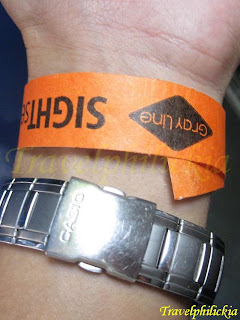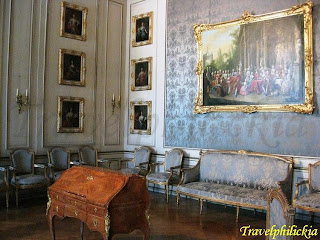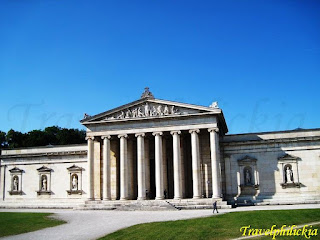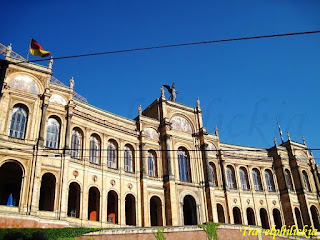Took an early train at 0724 hours which departed from Neuchâtel to München Hauptbahnhof. Probably addicted by the coffee from my Swiss Company, during the train ride I bought a cup of coffee at CHF 3.90 from a push-cart coffee machine. Unexpectedly the coffee came with two pieces of biscuits (left photo below). This "caffeine injection" could only last me for a few hours before lunch time.
The train journey was not direct; we had to transit at St. Gallen (right photo below) and changed to another regional train to Munich. After a long ride for about 6 hours, we finally reached Munich Central Station at 1328 hours.


Once out of the train station, we tried to look for our hostel to deposit our luggage. However after almost 10-mins search, we still couldn’t find it. Desperate for time and food, we next headed straight to a departmental store 'Karstadt' behind the sightseeing bus waiting area to grab our water and bread. After a quick bite, we then boarded the sightseeing bus for Grand Circle Route (left photo below). For identification purposes, each passenger was given an orange tag to put on (right photo below).


Nymphenburg Palace
Our first stop: Nymphenburg Palace. Also known as Schloss Nymphenburg in German, this palace used to be the main summer residence for rulers of Bavaria. Construction began in 1664 and only till 1675 that the central pavilion was completed. Since then several expansion occurred until the last owner.
From the bus, the Main Palace building (left photo below) and Court Stable (right photo below) can be seen from afar with large ponds in front. Initially our intention was just visit the exterior of the palace by taking photos of the palace façade (bottom photos).




However, we changed our mind after browsing some souvenir books about the palace and confirming with the counter staff that we can take photos inside. Right after depositing our luggage at the lockers, we then walked up the stairs to the second floor.
All of us were simply stunned by the interior decoration of this hall! Known as Steinerner Saal in German, the Stone Hall (photos below) is the most impressive sight in the Palace. Acting as a grand hall, it occupies over three floors of the central pavilion of the palace. The monumental room design is of late Rocco court art in Bavaria (bottom photos).




The giant ceiling fresco depicts the Olympian gods (photos below).


We then proceed to visit the other rooms within the pavilion. Some of them still have the original baroque decoration (photos below), while others were renovated in rococo or neoclassical style.


One special room is the 'Galleries of Beauty' where 36 portraits of the most beautiful women are displayed (photos below). These women were from a variety of classes, ranging from daughters of shoemaker to princesses, were painted from 1826 to 1850 under the orders of King Ludwig I.




The Bedroom of Queen Caroline still has its original furnishings (photos below). The furniture is in the French Empire style, but was made in 1815 in the court joinery at Munich. This room also houses the birthroom of King Ludwig II of Bavaria.


After the palace tour, we then decided to visit its garden (photos below), of which is highly landscaped with a variety of flowers and decorations.


The garden is located at the rear of the palace (left photo below), occupying almost 8 hectares of land. What caught our attention was the fountain in the middle of the park ejecting out from a pile of rocks (right photo below).


The stone statues of Greek gods and goddess, made in the late eighteenth century, are located at the western side of the garden. Through the internet search, I could identify Asclepius – God of Medicine (left photo below), Neptune – God of Water and Seas (right photo below), Zeus – mighty King of the Olympian Gods (bottom left photo), and Hera – Goddess of Love and Marriage (bottom right photo).




Souvenir hunters definitely won’t be disappointed by the wide variety of souvenirs available in the modern design museum shop (photos below).


Admission to the Palace cost EUR 5 and its opening hours from 0900 to 1800 hours (Apr to mid-Oct) or 1000 to 1600 hours (mid-Oct to Mar). We got to the palace by alighting at bus stop number 7 from Gray-line sightseeing bus Grand Circle line.
Olympic Park
Our next stop: Olympic Park or Olympiapark was constructed for 1972 Summer Olympic Games. It encompasses the Olympic Stadium, Olympic Hall and Olympic Swim Hall, of which all are connected by web-like canopy (photos below).


The Olympic Tower (left photo below) is the most recognizable structure towering at 291-meters. It has become an observatory tower after the games. Another structure that is converted to public usage is the SoccArena (right photo below) for street-soccer. We only took about 15-mins to walk around the park before moving on to our next destination.


We got there by alighting at bus stop number 8 from sightseeing bus Grand Circle line.
BMW World
Located opposite the Olympiapark, it is where BMW Headquarters and BMW museum are situated (left photo below). However we didn’t go into the museum due to limited time. Instead we took a visit inside the BMW World (right photo below).


The BMW World or BMW Welt in German is a exhibition facility that is opened in Summer 2007 to showcase its latest product and as a communication center for its customer (photos below).


Latest models of convertible automobiles such as this Z4 sDrive35is (left photo below) and M3 cabrio (right photo below) were just some of the spot-lights in the exhibition. The technology involves in the design allows each driver to experience safety, comfort and driving pleasure within the limited space (bottom photos).




Other types of cars such as the Hybrid automobile (left photo below) and 335i sedan (right photo below) allows its customer more selection.


Besides the sleek design of the outer cast, the comfort of its leather seat (left photo below) and wide selection of colors (right photo below) also played an important factor for fastidious customers to be fully satisfied.


Not just an exhibition center for automobile showcase, the BMW World also provides some displays of its machinery development (photos below). This allows its visitors to have a better understanding of the design and technology involved.


No admission cost is required to visit this BMW World, and its opening hours from 0900 to 2000 hours daily.
Munich City Tour
After hopping back to the sightseeing bus, we decided to follow the Grand Circle line route.
First structure we saw was the Siegestor. Also known as Victory Gate, this three-arched is crowned with a statue of Bavaria with lion-quadriga (left photo below). Several similarities can be spotted to the following Arches: Arch of Constantine in Rome, Marble Arch in London, Arc de Triomphe in Paris and Brandenburger Tor in Berlin.
Second structure was the obelisk (right photo below) located at Karolinenplatz. The obelisk was originally intended to be sited on Odeonsplatz, however in 1833 it became clear to Crown Prince Ludwig that Karolinenplatz needed a strong focal point; thus this 29-meters high obelisk fitted the bill perfectly. This strcture is a memorial to over 20,000 Bavarian soldiers who died during Napoleon's Russian campaign, and interestingly contains a number of metal plates made from melted down Bavarian cannons.


The blue O2 (left photo below) is one of the tallest corporate buildings in Munich. The wafer-thin building rises 146-metres into the sky and reflects the city in its single-shell all-glass façade.
Probably the most famous landmark in Munich is this Frauenkirche (right photo below). Also known as 'Cathedral of Our Dear Lady', its church towers are widely visible from every corner due to the city height limits where new buildings are prohibited to have a height exceeding 109-meters. Sadly one of its towers was undergoing renovation during our visit.


The New Justizpalast (left photo below) is in contrast to the earlier Justizpalast by using red brick stone in northern neo-gothic style. Built in 1905, the New Justizpalast now houses the Bavarian Constitutional Court and the Higher Regional Court.
The Glyptothek (right photo below) is a museum located at Königsplatz, which was commissioned by the Bavarian King Ludwig I to house his collection of Greek and Roman sculptures.


The Friedensengel or Angel of Peace is a monument located at Maximilian Park which consists of a fountain, an observation deck and a column (left photo below). The column itself is 38-meters high of which a 6-meters Angel of Peace statue stands upon it (right photo below).


Another impressive building is the Maximilianeum (left photo below). Built in 1874, now it is a palatial building to house the State Parliament.
The National Theatre Munich (right photo below) is an opera house built in 1753. It now houses the Bavarian State Opera and State Ballet.


Marienplatz
We finally alighted at Marienplatz or Mary’s Square (left photo below) which is our last destination of sightseeing bus tour. The Old Town Hall (right photo below) or Altes Rathaus in German, stands at east side of the square. This building served as domicile for the municipality until 1874 where it moved to the New Town Hall.


The New Town Hall (left photo below) or Neues Rathaus in German is an impressive building with Gothic revival style of façade (right photo below). Built between 1867 and 1908, currently it is occupied by a large restaurant and several shops, including a tourist information center. The main tower (bottom left photo) has a height of 85-meters and viewing platform is available to visitor by an elevator. The Rathaus-Glockenspiel (bottom right photo) or musical clock is a popular tourist attraction. Everyday at 1100 hours (as well as 12 noon and 1700 hours in summer), it chimes to amuse mass crowds of locals and tourists.




Dinner at Viktualienmarkt
What is the best dish that can represent Munich? My answer is either Schweinebraten (roasted pork) or Schweinshaxe (roasted pig's knuckle). While walking towards Hard Rock Café, we happened to see this restaurant 'Münchner Spezialitäten' (left photo below) at Viktualienmarkt. Thus we decided to taste the 'Specialty Food in Munich'.
Viktualienmarkt is a food market and square for various gourmets, flower shops, bakeries and restaurants.
We shared the famous 'currywurst' (right photo below) among us. While I ordered a Schweinshaxe (bottom left photo) for myself at EUR 10.90 and my colleagues ordered Schweinebraten (bottom right photo) at EUR 9.90. Schweinshaxe is a roasted pork knuckle dish that is very popular in Bavaria region.




The meat of Schweinshaxe was tender and the roasted skin was uber crispy. Total cost paid for this delicious dinner was EUR 15 per person, which included the shared food and drinks ordered.
Hard Rock Café Munich
We took about 5-mins walk from Marienplatz to this Hard Rock Café (left photo below). Located at Platzl 1, the nearest Metro station is Marienplatz.
Here’s the direction: take the 'Viktualienmarkt' Exit at 'Marienplatz', head towards the Spielzeugmuseum (Toy Museum). Walk underneath the arches of the museum and then turn left into the Sparkassenstrasse till the Münzstrasse (on the corner there is a shop that sells traditional Bavarian clothes) can be spotted. Then turn right and the Hard Rock Cafe will be at the next cross junction.
Several memorabilia such as the custom made guitars (right photo below) are on display inside the café.


Hofbräuhaus München
Located just opposite the Hard Rock Cafe, this Hofbräuhaus München (left photo below) consists of a restaurant and a souvenir shop that sell products related to Munich’s famous beer 'Hofbräuhaus'. The restaurant occupied the ground floor of the building (right photo below). Underneath the cross vaults, up to 1,300 guests can be seated at its classic tables. Some of these tables are as old since 1897, which can be testified by the many initials, names and comments engraved on them.


After gotten our souvenirs, we then walked back to Marienplatz to take a U-bahn train back to Central station. At the Central station, we bought our Bayern group tickets before checking into our A&O hostel for the night.
 Posts RSS
Posts RSS


